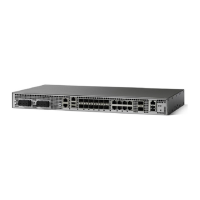Only MPLS encapsulation is supported.Note
SUMMARY STEPS
1.
l2 vfi name manual
2.
vpn id vpn-id
3.
bridge-domain vlan-id [access | dot1q [tag] | dot1q-tunnel] [broadcast] [ignore-bpdu-pid] [pvst-tlv
CE-vlan] [increment] [lan-fcs] [split-horizon]
4.
neighbor remote router id [vc-id-value] {encapsulation mpls}[no-split-horizon]
5.
shutdown
DETAILED STEPS
PurposeCommand or Action
Enables the Layer 2 VFI manual configuration mode.l2 vfi name manual
Example:
Router(config)# l2 vfi vfi17 manual
Step 1
Configures a VPN ID for a VPLS domain. The emulated VCs bound
to this Layer 2 VRF use this VPN ID for signaling.
vpn id vpn-id
Example:
Router(config-vfi)# vpn id 1000
Step 2
Places the VFI in the same bridge domain as the access interface.
bridge-domain vlan-id [access | dot1q [tag] |
dot1q-tunnel] [broadcast] [ignore-bpdu-pid]
Step 3
[pvst-tlv CE-vlan] [increment] [lan-fcs]
[split-horizon]
Example:
Router(config-vfi)# bridge-domain 1000
Specifies the remote peering router ID and the tunnel encapsulation
type or the pseudo wire property to be used to set up the emulated
VC.
neighbor remote router id [vc-id-value]
{encapsulation mpls}[no-split-horizon]
Example:
Router(config-vfi)# neighbor 1.5.1.1 101
encapsulation mpls
Step 4
Split horizon is the default configuration to avoid broadcast
packet looping and to isolate Layer 2 traffic. Use the
no-split-horizon keyword to disable split horizon and to
configure multiple VCs per spoke into the same VFI.
Note
The optional VC ID value identifies the emulated VC
between a pair of peering PE routers.
Note
Disconnects all emulated VCs previously established under the Layer
2 VFI and prevents the establishment of new attachment circuits.
shutdown
Example:
Router(config-vfi)# shutdown
Step 5
It does not prevent the establishment of new attachment
circuits configured with the Layer 2 VFI using CLI.
Note
MPLS Basic Configuration Guide, Cisco IOS XE Everest 16.5.1 (Cisco ASR 900 Series)
119
VPLS Configuration over MPLS-TP
Configuring the VFI in the PE

